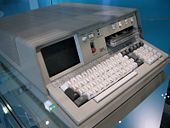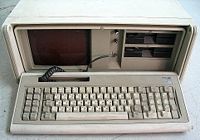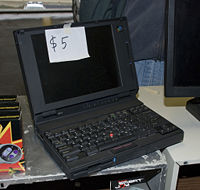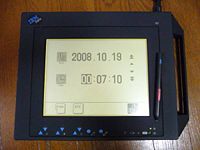ThinkPad
ThinkPad is a professional-oriented brand of laptop and tablet PCs from Lenovo. The product line was a part of the IBM's PC division, which was sold to the Chinese company in 2005. The ThinkPad was first conceived as a dedicated tablet without a keyboard, but it emerged mainly as a notebook brand with the successful debut of the models 700 and 700C in October 1992. The 700/C and the subsequent ThinkPad models took the iconic shape of a black rectangular case and a keyboard featuring a red pointing device.
History
The ThinkPad's beginning can be traced back to the 1980s when mobile computing was emerging in the form of microcomputers. The earliest form of mobile computing was the portable computer, which incorporated the keyboard and display into the main body in a more conveniently "transportable" package. Although the first portable computer was the IBM 5100 Portable Computer introduced in 1975,[1] it occupied only a small niche among engineers and analysts due to its hefty price tag that ranged from $9,000 to $20,000.[2] While IBM followed up the 5100 with the 5110 portable[3] and the desktop systems 5520 and 5120 from 1978 to 1980,[4][5] much of IBM's focus shifted back to its traditional mainframe business that was more profitable.[6]
But it was precisely during this period when a new market developed for affordable "home/personal" computers that were up to several thousand dollars cheaper than their corporate counterparts. To be able to compete in this rapidly growing sector of the computing industry, IBM started "Project Chess" and collaborated with Intel and Microsoft under an open architecture approach to develop the IBM PC. Unlike the other IBM products, the PC was built with non-IBM, off-the-shell components and was open to third-party software,[9] as that would allow a shorter development period and result in a low-level entry product which would avoid cannibalizing the more powerful Display Writer.[10] At the time of the IBM PC's release, in August 1981, Apple, Commodore, and Tandy controlled 75% of the US market share. Although the IBM PC lacked obvious technological edge over the competition, it was able to gain 28% of the market share and become the industry standard within 2 years due to IBM's dominant brand and extensive sales force.[6][11][12]
The PC's open hardware architecture, which allowed developers to freely add on hardware and software to improve the features and performance of its PCs
In response to the success of the Compaq Portable that was released in November 1982,[13] IBM announced the Portable Personal Computer (5155 model 68) in February 1984. Although IBM's entry into the portable market was highly anticipated and was preceded by declines in stocks prices of competitors like Compaq, the 5155 was revealed to be a very mediocre product that merely reinforced the market dominance of the Compaq Portables.[7]
I wanted to create a volume as simple as possible and as expressive as possible... and I thought the form of a cigar box, which at that time corresponded to the dimensions... more or less than a laptop computer had to have, would be an expression of what I wanted to do. I wanted to make an object that looks like a black cigar box and that shows on the outside nothing of being what it is... except for the logo of the producer. Then, when you open it, you see this is not a cigar box, but it is a computer, and you see all the complicated stuff inside. And that would create a surprise, and this is the basic concept of the ThinkPad.
- Richard Sapper
notes
- ↑ Tech Republic staff. "Photos: Dinosaur Sightings: 1970s computers." cnet news. 12 Oct. 2007. Web. 12 Sept. 2009.
- ↑ "IBM 5100 Portable Computer." IBM Archives. IBM. Web. 12 Sept. 2009.
- ↑ "IBM 5110." IBM Archives. IBM. Web. 12 Sept. 2009.
- ↑ "IBM 5520." IBM Archives. IBM. Web. 12 Sept. 2009.
- ↑ "IBM 5120." IBM Archives. IBM. Web. 12 Sept. 2009.
- ↑ 6.0 6.1 Reilly, Edwin D. "IBM Corporation." The ACM Digital Library. University of Rochester. Web. 12 Sept. 2009.
- ↑ 7.0 7.1 SANDBERG-DIMENT, ERIK. "Advertise on NYTimes.com PERSONAL COMPUTERS; RIVALS STAY ONE STEP AHEAD OF I.B.M. PORTABLE." The New York Times 13 Mar. 1984. www.nytimes.com. Web. 12 Sept. 2009.
- ↑ Deborah and Purdy. pp. 19-39.
- ↑ "The History Of The IBM Personal Computer." COMPUTE MAGAZINE. 02 Mar. 2009. Web.
- ↑ Van, 2008. pp. 240.
- ↑ Taylor, Alexander L., and Frederick Ungeheuer. "IBM Is Homeward Bound." Time Magazine 24 Aug. 1981. Time. Web. 12 Sept. 2009.
- ↑ Moritz, Michael, and Alexander L. Taylor III. "Now No. 2, Apple Tries Harder." Time Magazine 26 Sept. 1983. TIME.COM. Time Inc. Web. 13 Sept. 2009.
- ↑ "Computer." Encyclopædia Britannica. 2009. Encyclopædia Britannica Online. 12 Sep. 2009.




